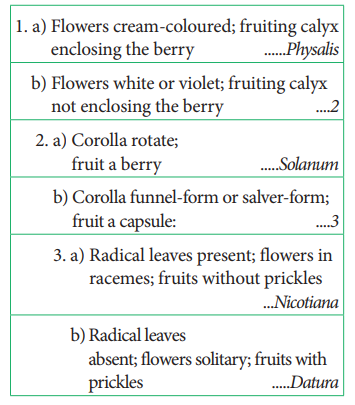Keys, Flora, Monograph | Botany - Taxonomic Aids | 11th Botany : Chapter 5 : Taxonomy and Systematic Botany
Chapter: 11th Botany : Chapter 5 : Taxonomy and Systematic Botany
Taxonomic Aids
Taxonomic Aids
Taxonomic aids are the tools for the taxonomic
study. Some techniques, procedures and stored information that are useful in
identification and classification of organisms are called taxonomical aids. They are required in almost all branches of biological studies for their proper
identification and for finding their relationship with others. Some of the
taxonomical aids are keys, flora, revisions, monograph, catalogues, herbarium,
botanical gardens etc.
1. Keys
Taxonomic keys are the tools for the identification
of unfamiliar plants. These keys are based on characters which are stable and
reliable. The most common type of key is a dichotomous key. It consists of a
sequence of two contrasting statements. A pair of contrasting statements is known
as couplet. Each statement is known
as lead. The plant is correctly
identified with keys by narrowing down the characters found in plant.
Example:

Another type of key for identification is the Polyclave or Multi-entry key. It consists of a list of numerous character
states. The user selects all states that match the specimen. Polyclave keys are
implemented by a computer algorithm.
2. Flora
Flora is the document of all plant species in a
given geographic area. Flora consists of total number of plant species in an
area and gives information about flowering season, fruiting season and
distribution for the given geographic area. It also provides details on rare
and endemic species of that area. Example: Flora of Tamil Nadu Carnatic by K.M.Matthew.
Floras are categorized based on the scope and area covered.
Local Flora
It covers the limited areas, usually state, country, city or mountain range. Example: ŌĆśFlora of Thiruvannamalai DistrictŌĆÖ by R. Vijaysankar, K. Ravikumar and P. Ravichandran.
Regional Flora
It includes large geographical area or a botanical
region. Example: ŌĆśFlora of Tamil NaduŌĆÖ Carnatic by K.M.Matthew (1983), ŌĆśFlora of Madras PresidencyŌĆÖ by J.S. Gamble and Fischer.
Continental Flora
This flora covers the entire continent.
Example: ŌĆśFlora of EuropaeaŌĆÖ by D.A.Web.
Electronic Floras (e - floras)
It is nothing but the digitized form of a flora
published online. Example: ŌĆśe ŌĆō Flora ChinaŌĆÖ. This provides the information and
also functions as an identification tool.
3. Monograph
A Monograph is a complete global account of a taxon
of any rank ŌĆō family, genus or species at a given time. This includes the
existing taxonomic knowledge and all relevant information about the group
concerned such as Anatomy, Biochemistry, Palynology, Chromosome Number and
Phylogeny. It also includes extensive literature review, all nomenclatural
information, identification key to all taxa, citation of specimens examined and
distribution map.
Example: The Family Lentibulariaceae by Peter Tylor.
Revisions
Taxonomic revision is carried out for a family or
genus. Usually taxonomic revision is less comprehensive than a monograph for a
given geographical area. Revisions normally incorporate keys to identify the
taxa, short descriptions, often confined to diagnostic characters, distribution
maps and a classification. Illustrations mostly in the form of line drawings
are included both in monographs and revisions. There are difficulties in
identifying various members within a taxon. If there is inconsistency of the
characters within the taxonŌĆÖs geographic range then a revision is needed.
Taxonomic revisions are primarily based on original research work. Example:
Malvaceae of India by T.K.Paul, Venu. P. 2006 Strobilanthes (Acanthaceae) in
Peninsular India.
Catalogues
Catalogues are the books of libraries rich in
botanical titles. They have special value in taxonomic studies. To refer a
catalogue, one should know full name of the author, exact title of the book,
exact date of publication the particulars of edition.
Example: Catalogue of the Library of British Museum
(of Natural History) Catalogue of the Library of the Massachusetts
Horticultural Society.
Related Topics